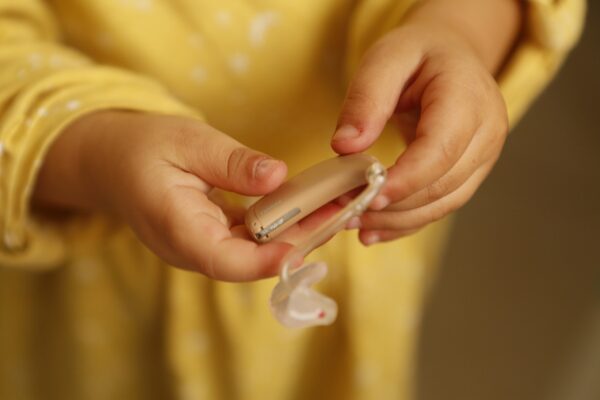Hearing aids are remarkable devices that help millions of people regain their sense of hearing and improve their quality of life, until the need for hearing aids repair.
However, like any technological device, they can experience issues and fail over time.
In this blog post, we will explore the common causes of hearing aid failure and delve into the steps involved in their repair.
Whether you’re a hearing aid user or simply interested in understanding the repair process, this article will provide you with valuable insights into the world of hearing aids repair.

Understanding Hearing Aid Failure
Hearing aids are sophisticated electronic devices that can encounter various problems leading to their malfunction.
Let’s explore some common causes of hearing aid failure:
- Wax and Moisture Buildup: Accumulation of earwax or exposure to moisture can clog the hearing aid’s components, including the microphone or receiver, resulting in muffled or distorted sound.
- Battery Issues: Dead or weak batteries can cause hearing aid failure. Regular battery replacement and proper handling are essential for optimal performance.
- Physical Damage: Drops, impacts, or rough handling can damage the delicate components of the hearing aid, such as the casing, microphone, or volume control, leading to functional issues.
- Software and Programming Errors: Sometimes, errors in the hearing aid’s software or incorrect programming settings can disrupt its performance, affecting sound quality or causing sudden malfunctions.
- Aging Components: Over time, the internal components of a hearing aid may wear out, degrade, or become loose, resulting in reduced effectiveness or complete failure.
- User Errors: Improper handling, maintenance, or cleaning techniques, as well as neglecting regular check-ups, can contribute to hearing aid failure.
Hearing Aids Repair
When hearing aids repair is needed, it’s crucial to follow the appropriate steps to ensure a prompt and effective resolution.
Here are the general steps involved in the repair process:
- Diagnostic Evaluation: Start by contacting a qualified hearing aid repair service or an audiologist. They will examine your device to identify the root cause of the malfunction. This evaluation may involve testing the microphone, receiver, battery, and other components.
- Repair Assessment: Once the issue has been diagnosed, the repair technician will determine whether the problem can be fixed through repairs or if the hearing aid requires replacement parts.
- Component Replacement: If a specific component is faulty or damaged, the technician will replace it with a new one. This process may involve replacing the microphone, receiver, tubing, or other essential parts.
- Cleaning and Maintenance: After replacing or repairing the defective components, the technician will clean and sanitize the hearing aid thoroughly to ensure optimal performance. This step involves removing accumulated wax, debris, or moisture.
- Calibration and Programming: If necessary, the technician will recalibrate or reprogram the hearing aid to restore its sound quality and functionality. This step ensures that the device matches the specific hearing needs of the user.
- Quality Testing and Return: Once the repairs are complete, the repaired hearing aid undergoes a series of quality checks to ensure its proper functioning. Finally, the device is returned to the user, along with any instructions or recommendations for ongoing maintenance and care.
Hearing aids are incredible devices that can significantly improve the lives of individuals with hearing loss.
However, they are not immune to issues and failures.
By understanding the common causes of hearing aid failure and the repair process involved, users can promptly address any problems that arise.
Remember, seeking professional assistance from a qualified hearing aid repair service or an audiologist is crucial to ensure accurate diagnosis and effective repairs.
But when your hearing aids are undergoing repairs, TV Ears can serve as a valuable temporary solution.
Here are some key benefits of using TV Ears:
- Enhanced Sound Clarity: TV Ears utilizes specialized sound processing technology to amplify and clarify television audio. It helps overcome background noise and delivers customized sound directly to the user’s ears, ensuring a clearer and more enjoyable TV-watching experience.
- Adjustable Volume and Tone: TV Ears allows users to adjust the volume and tone settings according to their personal preferences. This feature ensures that individuals with different degrees of hearing loss can customize their listening experience and find the optimal sound level.
- Convenience and Portability: TV Ears is a wireless device, providing freedom of movement and convenience. You can move around your living space without being tethered to the TV or worrying about tangling cords. Additionally, it is compact and easy to transport, making it suitable for travel or temporary use.
- Independent Listening: TV Ears allows individuals to enjoy their favorite programs without disturbing others in the room. Whether you’re watching late at night or have different sound preferences than those around you, TV Ears ensures a personalized audio experience.
- Easy Setup and Compatibility: Setting up TV Ears is straightforward and typically requires connecting the transmitter to the TV’s audio output. It is compatible with most televisions and can be used with or without hearing aids.
When the need for hearing aids repair comes, don’t let unclear TV audio dampen your entertainment.
TV Ears offers a convenient and effective solution to enhance sound clarity while you await the return of your repaired hearing aids.
With adjustable settings, portability, and independent listening capabilities, TV Ears ensures an enjoyable TV experience for individuals with hearing difficulties.
Remember, in some cases, TV Ears may be a temporary solution, as it’s essential to have your hearing aids repaired as soon as possible to regain the full benefits of personalized sound amplification, but can be a valuable asset for TV watching anytime!
Looking for more? Check out these recent TV Ears blog entries:
Looking at a headset for TV listening? Consider these five outcomes
Enhance Your TV Viewing Experience with the Best Hearing Devices for TV
Headphones as hearing aids; Know this 1 vital factor
Need wireless headphones for TV transmitter? Check out TV Ears
A Headphone for TV Use? 5 things to know
Wireless headphones for tv’s: Many options, 1 top choice for those with hearing impairments
TV hearing devices: Lots of options, 1 clear winner
TV headphones for hearing impaired: 6 reasons TV Ears is a best choice


